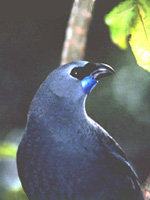|
| |
| |
NEW ZEALAND ECOLOGY |
| |
|
| |
WATTLEBIRDS |
| |
Three unique wattlebirds with an ancient lineage, the extinct huia, and extant kokako and saddleback, make up the total Callaeidae family. The family is endemic to New Zealand. Five species in three genera are not closely related to Australian wattlebirds or any other species in the world. The New Zealand wattlebirds are thought to have arrived as wind blown migrants during the Paleocene 60 million years ago, when they were probably able to fly better than they do today.
Wattlebirds migrated at about the same time as two other distinctive families of New Zealand land birds, wrens and native thrushes. These three families are not found in any other part of the world. Most of them developed ground feeding habits, and in some cases various degrees of flightlessness in a predator-free ecosystem. Extinctions occurred after human settlement when mammals were introduced and habitat was destroyed by fire or converted to pasture. |
|
| |
|
|
|
The North Island kokako is highly endangered - the only naturally remaining wattlebird on the mainland. Small populations are intensely managed through captive breeding, trans-location and predator control in 'mainland island' or fenced sanctuaries. The South Island kokako hasn't been seen for three decades and is assumed to be extinct. Kokako eat fruit from 12 trees, but are not a significant seed disperser because of their limited range. Only kokako and kereru can swallow the largest native taraire fruit.  See more See more
 Hear the song of North Island kokako Hear the song of North Island kokako |
 |
|
Image above top: Female (left) and male (right) huia, Copyright © Peter Schouten.
Above right: North Island kokako, photo Rogan Colbourne, Crown Copyright © Department of Conservation.
Centre top: John Gerrard Keulemans 1842-1912, Huia Heteralocha acutirostris 1888. Permission of the Alexander Turnbull Library, Wellington, New Zealand must be obtained before any re-use of this image.
Centre bottom: North Island saddleback, photo J.L. Kendrick, Crown Copyright © Department of Conservation.
|
|
| |
|
|

